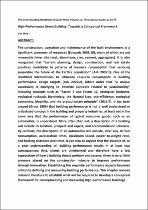JavaScript is disabled for your browser. Some features of this site may not work without it.
- ResearchSpace
- →
- Research Publications/Outputs
- →
- Book Chapters
- →
- View Item
| dc.contributor.author |
Van Wyk, Llewellyn V

|
|
| dc.date.accessioned | 2017-06-07T07:11:53Z | |
| dc.date.available | 2017-06-07T07:11:53Z | |
| dc.date.issued | 2016-10 | |
| dc.identifier.citation | Van Wyk, L.V. 2016. High-Performance Green Building: Towards a Conceptual Framework. In: The Green Building Handbook of South Africa Volume 10: The Essential Guide, p. 64-79 | en_US |
| dc.identifier.uri | http://alive2green.com/wp-content/uploads/2016/07/GBH-2016-UPDATED_.pdf | |
| dc.identifier.uri | http://hdl.handle.net/10204/9182 | |
| dc.description | Copyright: 2016 Alive2green. Due to copyright restrictions, the attached PDF file only contains the abstract of the full text item. For access to the full text item, please consult the publisher's website. | en_US |
| dc.description.abstract | The construction, operation and maintenance of the built environment is a significant consumer of resources (Edwards 2002:10), many of which are not renewable (inter alia steel, aluminium, clay, cement, aggregates). It is also recognised that “current planning, design, construction, and real estate practices contribute to patterns of resource consumption that seriously jeopardize the future of the Earth’s population” (AIA 2005:1). One of the identified interventions to influence resource consumption is building performance design targets (AIA 2005:2). Kibert notes that “a unique vocabulary is emerging to describe concepts related to sustainability” including concepts such as “Factor 4 and Factor 10, ecological footprint, ecological rucksack, biomimicry, the Natural Step, eco-efficiency, ecological economics, biophilia, and the precautionary principle” (2013:7). It has been argued (Gross 1996) that building performance is not a well understood or articulated concept in the building and property industries, at least not in the same way that the performance of typical consumer goods, such as an automobile, is understood. More often than not, a description of a building will include its location, prospect and aspect, and accommodation schedule. By contrast, the description of an automobile will include, inter alia, its fuel consumption, acceleration times, maximum speed, power-to-weight ratio, and braking distances and times. It can also be argued that the absence of, or a poor understanding of, building performance results in at least two consequences: first, clients are uninformed and therefore have a low expectation of how a building should perform and second, there is no or little pressure placed on the construction industry to improve performance through innovation. Establishing the requisite performance aspects becomes critical to defining and measuring building performance. This chapter reviews relevant literature to establish what will be required to develop a conceptual framework for conceptualising and measuring high-performance buildings. | en_US |
| dc.language.iso | en | en_US |
| dc.publisher | Alive2green | en_US |
| dc.relation.ispartofseries | Worklist;17965 | |
| dc.subject | Green buildings | en_US |
| dc.subject | Building life cycle assessments | en_US |
| dc.subject | Construction industry improvements | en_US |
| dc.title | High-Performance Green Building: Towards a Conceptual Framework | en_US |
| dc.type | Book Chapter | en_US |
| dc.identifier.apacitation | Van Wyk, L. V. (2016). High-Performance Green Building: Towards a Conceptual Framework., <i>Worklist;17965</i> Alive2green. http://hdl.handle.net/10204/9182 | en_ZA |
| dc.identifier.chicagocitation | Van Wyk, Llewellyn V. "High-Performance Green Building: Towards a Conceptual Framework" In <i>WORKLIST;17965</i>, n.p.: Alive2green. 2016. http://hdl.handle.net/10204/9182. | en_ZA |
| dc.identifier.vancouvercitation | Van Wyk LV. High-Performance Green Building: Towards a Conceptual Framework.. Worklist;17965. [place unknown]: Alive2green; 2016. [cited yyyy month dd]. http://hdl.handle.net/10204/9182. | en_ZA |
| dc.identifier.ris | TY - Book Chapter AU - Van Wyk, Llewellyn V AB - The construction, operation and maintenance of the built environment is a significant consumer of resources (Edwards 2002:10), many of which are not renewable (inter alia steel, aluminium, clay, cement, aggregates). It is also recognised that “current planning, design, construction, and real estate practices contribute to patterns of resource consumption that seriously jeopardize the future of the Earth’s population” (AIA 2005:1). One of the identified interventions to influence resource consumption is building performance design targets (AIA 2005:2). Kibert notes that “a unique vocabulary is emerging to describe concepts related to sustainability” including concepts such as “Factor 4 and Factor 10, ecological footprint, ecological rucksack, biomimicry, the Natural Step, eco-efficiency, ecological economics, biophilia, and the precautionary principle” (2013:7). It has been argued (Gross 1996) that building performance is not a well understood or articulated concept in the building and property industries, at least not in the same way that the performance of typical consumer goods, such as an automobile, is understood. More often than not, a description of a building will include its location, prospect and aspect, and accommodation schedule. By contrast, the description of an automobile will include, inter alia, its fuel consumption, acceleration times, maximum speed, power-to-weight ratio, and braking distances and times. It can also be argued that the absence of, or a poor understanding of, building performance results in at least two consequences: first, clients are uninformed and therefore have a low expectation of how a building should perform and second, there is no or little pressure placed on the construction industry to improve performance through innovation. Establishing the requisite performance aspects becomes critical to defining and measuring building performance. This chapter reviews relevant literature to establish what will be required to develop a conceptual framework for conceptualising and measuring high-performance buildings. DA - 2016-10 DB - ResearchSpace DP - CSIR KW - Green buildings KW - Building life cycle assessments KW - Construction industry improvements LK - https://researchspace.csir.co.za PY - 2016 T1 - High-Performance Green Building: Towards a Conceptual Framework TI - High-Performance Green Building: Towards a Conceptual Framework UR - http://hdl.handle.net/10204/9182 ER - | en_ZA |






